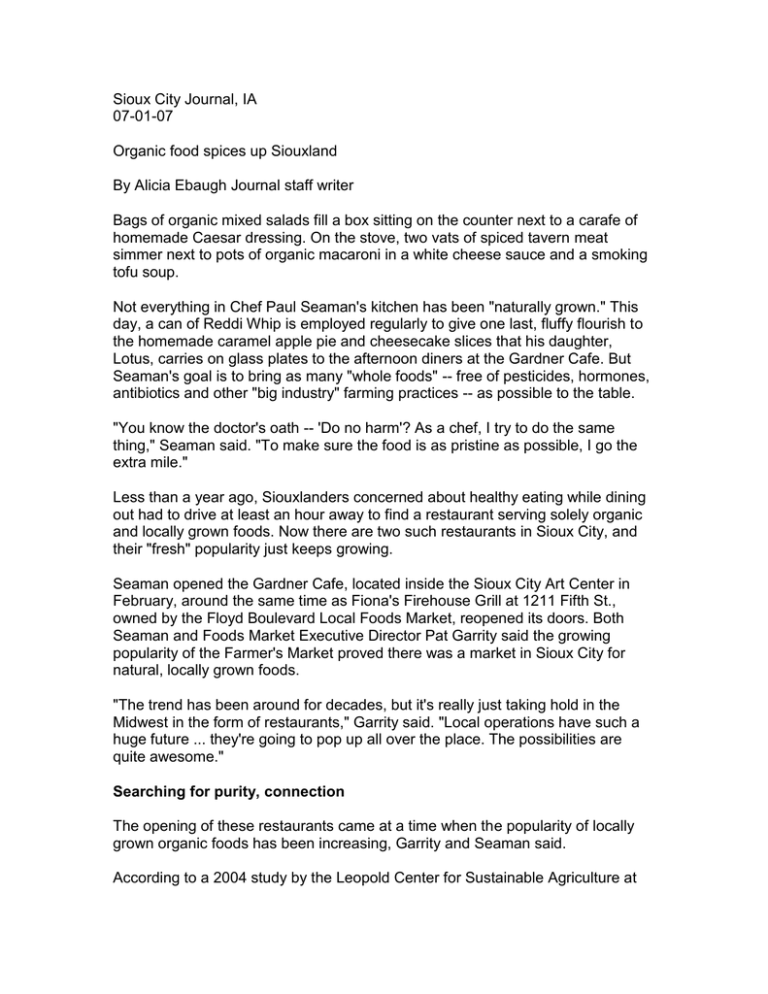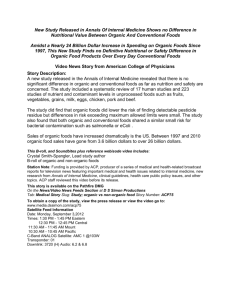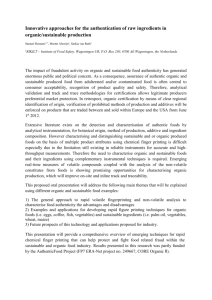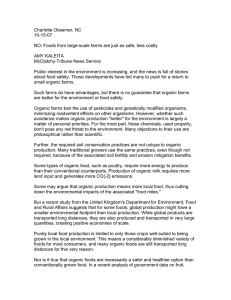Sioux City Journal, IA 07-01-07
advertisement

Sioux City Journal, IA 07-01-07 Organic food spices up Siouxland By Alicia Ebaugh Journal staff writer Bags of organic mixed salads fill a box sitting on the counter next to a carafe of homemade Caesar dressing. On the stove, two vats of spiced tavern meat simmer next to pots of organic macaroni in a white cheese sauce and a smoking tofu soup. Not everything in Chef Paul Seaman's kitchen has been "naturally grown." This day, a can of Reddi Whip is employed regularly to give one last, fluffy flourish to the homemade caramel apple pie and cheesecake slices that his daughter, Lotus, carries on glass plates to the afternoon diners at the Gardner Cafe. But Seaman's goal is to bring as many "whole foods" -- free of pesticides, hormones, antibiotics and other "big industry" farming practices -- as possible to the table. "You know the doctor's oath -- 'Do no harm'? As a chef, I try to do the same thing," Seaman said. "To make sure the food is as pristine as possible, I go the extra mile." Less than a year ago, Siouxlanders concerned about healthy eating while dining out had to drive at least an hour away to find a restaurant serving solely organic and locally grown foods. Now there are two such restaurants in Sioux City, and their "fresh" popularity just keeps growing. Seaman opened the Gardner Cafe, located inside the Sioux City Art Center in February, around the same time as Fiona's Firehouse Grill at 1211 Fifth St., owned by the Floyd Boulevard Local Foods Market, reopened its doors. Both Seaman and Foods Market Executive Director Pat Garrity said the growing popularity of the Farmer's Market proved there was a market in Sioux City for natural, locally grown foods. "The trend has been around for decades, but it's really just taking hold in the Midwest in the form of restaurants," Garrity said. "Local operations have such a huge future ... they're going to pop up all over the place. The possibilities are quite awesome." Searching for purity, connection The opening of these restaurants came at a time when the popularity of locally grown organic foods has been increasing, Garrity and Seaman said. According to a 2004 study by the Leopold Center for Sustainable Agriculture at Iowa State University, about 30 percent of Midwesterners think frequently about where and how their food is produced. These consumers are willing to pay 12 to 14 percent more for produce, meat, milk and eggs if they know where they came from and what practices are used, said Rich Pirog, Leopold Center assistant director. "More and more people are wanting transparency in their food system," Pirog said. "They're either buying local or organic because they're concerned about their own health, the environment or both. Especially after food scares, we're finding more people want to buy local because the chain isn't as long, it isn't as complicated. When you have more regional systems and there's a problem, the problem doesn't neccesarily affect the national population." The most important aspect of this new movement pushing the importance of organic foods is that the issue of health has been brought to the forefront, Garrity said. "Four of the top 10 diseases killing us are related to our diets," he said, referring to diabetes, obesity, coronary heart disease and colon and rectal cancer. "People have to realize there are costs to this so-called 'cheap food.'" Closely related to the health issue is the issue of taste, Garrity said. Fast food and even foods cooked at chain restaurants contain additives that "manufacture" a taste that is unnatural to the food, he said. Michael Pollan points out in his book "Omnivore's Dilemma" that food scientists cooked up the deliciously addictive taste of Kentucky Fried Chicken in a laboratory by finding the perfect mix of additives. "Most of the recipes are very, very secretive," Garrity said. "We're not too sure what a 'whole food' tastes like anymore." Seaman agreed, but also said people initially balk at the word "organic" -- they believe these foods naturally taste bad, but he said that is the furthest thing from the truth. "It's not an attractive buzzword here because there hasn't been a critical mass of good cooks making good organic food," said Seaman, a chef for more than 30 years. "People are only going by their experiences. They remember the things they've tasted weren't good." Support and promotion of locally grown natural foods also helps build the "fabric" of the community, Garrity said. "We need to make it profitable for people to stay here and move here," he said. "Having an outlet for them to sell their product while having the tranquility of raising only 50 or 60 acres of land -- right now, that's not profitable." In fact, the Floyd Boulevard Local Foods Market was recently given a grant by the Leopold Center to figure out just how to do that through something called a "processing feasibility study." In this project, many hours are spent calling area businesses assessing the demand for "environmentally friendly" local food products, then passing that information along to vegetable, fruit and animal producers. "We tell them then, 'This is the demand, can you plant this much and sell it to us?'" Garrity said. "With a reliable supply, more healthy food will be available to more people through our restaurant and elsewhere." Guaranteeing quality at the same cost Although both restaurants serve local and organic foods, Garrity and Seaman said each restaurant has its own philosophy on how to do it. To make sure his customers eat the best quality food possible, Seaman said he searches for the best organic providers of products used in his menu, such as buffalo for his buffalo lasagna or eggs for partner chef Anthony Pille's egg salad. He prefers to buy locally when he can, he said, but sometimes a naturally-grown product isn't available and he has to look elsewhere. "I would go with a certified organic product from Pennsylvania rather than a local sprayed product because I'm concerned about the health issues involved," he said. "I do a lot of research on where the food came from so the people who eat it can feel comfortable that they're making the best decision for themselves." As a result, Seaman buys organic food from many sources, including the Foods Market, grocery store chain Whole Foods and even Sam's Club. Fiona's Firehouse Bistro, on the other hand, relies heavily on members of the Food Market's producers cooperative to provide the fresh ingredients it needs. "I go out to the farms and look at their operations, I become familiar with how they do things," Garrity said. "I won't accept anyone into our program who doesn't fit our criteria." Those requirements are unbreakable, he said -- no hormones, antibotics or additives, no animals from large-scale Confined Animal Feed Operations, and no produce grown from genetically modified seeds. However, not all food in the restaurant is "certified organic" with the U.S. Department of Agriculture. "We understand it's a bit restrictive, monetarily and timewise, for a lot of producers," Garrity said. "We just stick to our standards and the product is still good." Executive chef Marlin Simpson and restaurant manager Lisa Jasman both came to Fiona's a few months ago after the closure of Botticelli's, an Italian restaurant that used to be located on Sioux City's north side. Simpson said that he didn't get to work with fresh local produce and meats before he came there, and the structure has given him a lot more freedom to create delicious dishes on a moment's notice. "A lot of the time I don't know what's going to be there when I come in," he said, rattling off a few of the featured foods he's made lately -- Indian tacos with locally-raised bison meat and an all-local meat and produce turkey pot pie. "It's a challenge, definitely, but it's fun. That's why I do it." Fortunately, the quality found in local, organic foods doesn't come with a higher price tag for diners. Although the higher prices that farmers command for naturally grown products are passed on to consumers at stores, the "direct connection" available to Gardner's and Fiona's has been able to keep prices reasonable, Garrity and Seaman said. From the farm to the table Patti Bancroft wipes her hands on her dirt-stained T-shirt as she points out the different organic vegetables and herbs she sells at the Floyd Boulevard Local Foods Farmer's Market -- some that make it into Fiona's Firehouse Bistro dishes. "Our vegetable garden grows every kind of vegetable anyone could ever want -we've got spinach, lettuce, potatoes, eggplant, tomatoes, radishes, beets, turnips, onions. And garlic. No one else has garlic around here," Bancroft said. Her partner on the farm, Mike Olsen, takes a pitchfork and digs up a green stalk of the pungent garlic, unearthing a tennis ball-sized white bulb. After washing it off under the water pump, he brings it over for Bancroft to smell. "They'll get about twice that size in a few weeks," she said. Bancroft has been farming her whole life on this plot of land north of Vermillion, S.D., but the 63-year-old only a few years ago took the steps to have 60 of her farm's 1,200 acres certified organic by the USDA. However, her family has always used more natural, sustainable agricultural processes, she said. As he knelt yanking weeds from the basil patch, her father, former Vermillion attorney Martin Weeks, said eating the food they've grown over the years has helped him stay healthy. "I can tell the difference if I have lettuce in the spring after a winter of dining on grocery store salads," he said. "I feel better, stronger when I eat more natural foods. "I wouldn't be doing this if I didn't think that because it's quite a lot of work," Weeks chuckled, throwing the weeds into a bucket. At Gardner's and Fiona's, the fruits of their labor end at the diner's table. Todd Osborn of Sioux City brought his three young sons and mother to the Gardner Cafe because he said he likes how good this locally grown, organic food tastes -and so do the kids. "I ended up having to get another tavern because my son ate it," Osborn said. "Did you like it, Jack?" "Uh-hum," Jack replied shyly. Osborn pointed to the empty plates that used to contain a tempeh sandwich (a type of soybean product comparable to tofu), organic mac 'n' cheese, and lasagna left scattered across the table. "I feel it's healthier for the kids, and you can tell they love it, too," he said.




